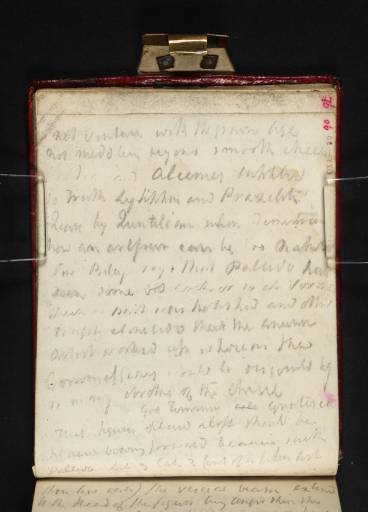Turner’s inscription reads:
not venture with the graver age | not meddling beyond smooth cheeks | Phidias and Alcemis supplied |so Truth Lysippus and Praxiteles | Censure by Quintilian where Demetrius | [?asks] how an artificer can be so natural | Sir Billy says that Palladio had | seen some old arch or two at Verona | some parts were polished and others | rough concluded that the ancient | artist worked up as there as the | Commissures could be disjointed by | so many strokes of the Chisel | ... ... grotesce | that figures placed aloft should be | placed bowing forward because saith | Palladio lib 3 cap 3 (out of a better art
This passage continues the notes on ancient artists begun on the verso (
D07737) before turning to later matters. The artist who is said to have preferred depicting youth to age is Polycletus.
Without transcribing it, Jerrold Ziff ascribes the commentary on ancient artists to Franciscus Junius’s
Painting of the Ancients (1638), but see notes to the verso for their origin in Wotton’s book, specifically his translation of Quintilian.
1 The source is confirmed by Turner’s next reference to ‘Sir Billy’ as he was apt to misremember Wotton’s name, for example in verses on his characterisation of the architectural orders:
Sir William Wootton often said
Tuscan like to the labourer is made...
2Turner continues by summarising (and rather misunderstanding) Wotton’s account of
a very mere fancie, strangely taken by Palladio, who, having noted in an old arch or two at Verona, some part of the materials already cut ... and some unpolished, doth conclude ... that the ancients did leave the outward face of their marbles or free-stone without any sculpture, till they were laid or cemented [as] the materials being left rough, were more manageable in the masons hand ... and that the sides might bee laid together the more exactly [but ] all these inducements cannot countervaile the sole inconvenience of shaking and disjointing the commissures ...
Turner’s next comment on adjusting the position of figures set high on buildings, also from Palladio
3 via Wotton, is developed on folio 89 verso (
D07735).
David Blayney Brown
May 2011

